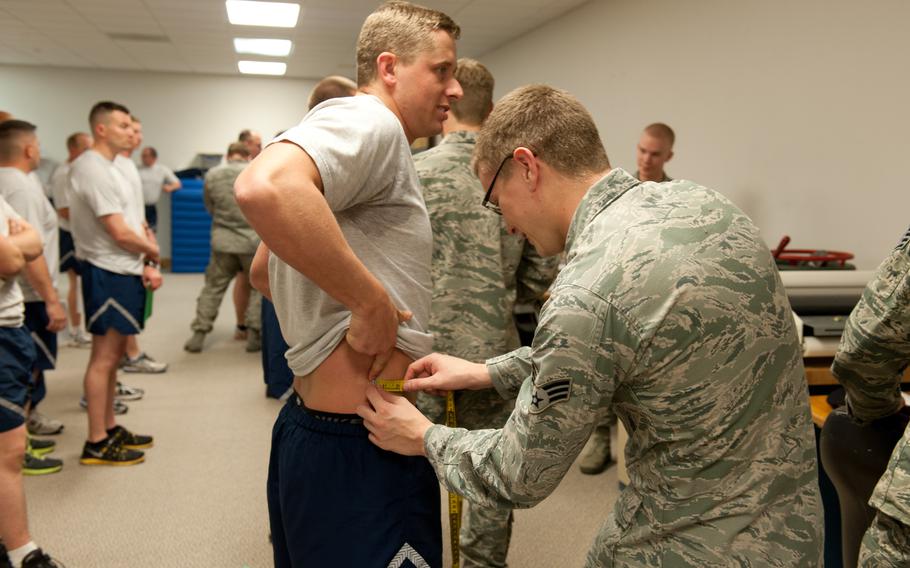
Airmen perform a waist measurement at Gowen Field, Idaho, in 2015. The service on Monday announced a new requirement for waist-to-height ratios that calculate body composition independent of the annual fitness fitness test requirement. (Cassie Morlock/U.S. Air Force)
The Air Force tape test is returning to base gyms and fitness testing facilities, two years after the service dropped the abdominal circumference measurement in fitness assessments.
The service is introducing a waist-to-height ratio that will determine whether airmen and Space Force guardians meet their annual fitness standards, according to a statement Monday.
The ratio is calculated by dividing waist circumference by height and cannot exceed 0.55.
For example, a person measuring 70 inches tall, or 5-foot-10, with a 38-inch waist would just barely pass with a ratio of 0.54.
The ratio aims to measure excess fat distribution in the abdominal region, the Air Force statement said.
Instead of the top of the hip bones, as before, measurements will be taken at the midpoint between the lowest rib and the top of the hip bones, which is normally the narrowest portion of the abdomen, according to the statement.
The new body composition assessment is mandatory but separate from the annual fitness test.
Initial failure to meet the body composition standard is “nonpunitive,” the service said Monday. Instead, overweight personnel will have to complete a yearlong “informal, self-directed body composition improvement program,” the statement said.
During the program, airmen will receive education on risk factors and may be referred for further medical evaluation.
Space Force members will be referred to so-called guardian resilience teams, which the service plans to establish soon.
While the abdominal circumference measurement under the new format may be less intimidating, it can still affect careers.
Missing scheduled measurement appointments can cause “commander-driven administrative actions.”
Measuring in the high-risk category after the 12-month grace period will be considered failure to meet standards and may result in reprimands, delayed promotions or separation.
Studies have found that waist-to-height ratio is a good indicator of body fat distribution and is strongly correlated with body mass index and other measures of body composition.
Excess fat in the abdominal region is associated with increased health risks such as cardiovascular disease, stroke, diabetes and hypertension.
As recently as 2019, service officials explored options for a gender-neutral fitness index. Initial proposals of the policy would have divided an airman’s running time by a waist-to-height ratio for a universal measurement of fitness among troops. The plan was ultimately scrapped.
In 2020, fitness testing was paused because of the COVID-19 pandemic. At the time, the service told airmen it would do away permanently with waist measurements.
A Defense Department policy updated last year, however, continues to require all services to maintain a body composition program for their members.
Airmen will complete their measurement each year in the month of their birthday. Guardians get a bit more leeway and have to log their composition in the quarter of their birthday.
Results will be tracked via myBodyComp, a new application under the troubled myFSS platform, the service said.
Assessments are expected to begin in April.